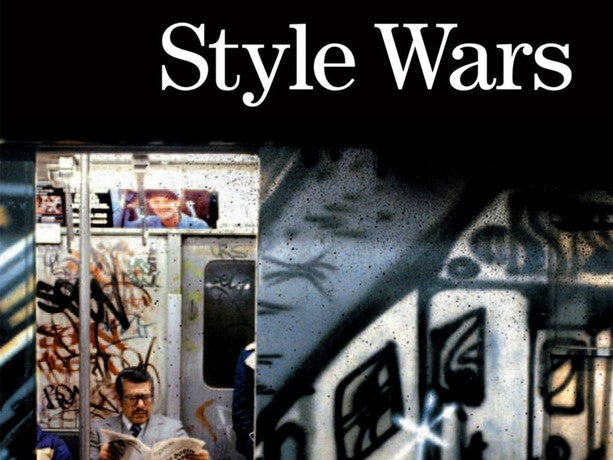From doodling during his lunch break at his desk job to gallery openings in Paris, over the course of the past decade Dean Stockton, popularly known as D-Face, has made his mark on the art scene.. This London native is one of the biggest figures in the contemporary street art scene, with his works appearing from alleyways to major museums all over the world. D-face’s rise, however, was anything but smooth. In 2004, Stockton was working a 9-5 office job, going mad as he sat mindlessly lost in the mundanity of everyday life. He knew that he wanted more, and that he had something bigger to offer

It Was Love of Art From the Start
Since he was a kid, Stockton (D-Face) had a passion for art. At a young age he discovered two photo series by American photography Henry Chafant, Subwayand Spraycan, which documented the graffiti within the New York City subway system. From that moment Stockton was hooked. The energy and style of street art, its inventiveness and rawness, its passion and nonconformity—these elements spoke to Stockton in ways that nothing had before.

As a teen, Stockton honed his graffiti interests through spending hours at the skate parks around his neighborhood. These teen punk havens were not just places where Stockton and his friends would go to skate, they were also sources of important artistic inspiration for a young D-Face. The art that covered the boards and ramps of the skate parks spoke to Stockton in the same way that the graffiti of the New York City subway system had. The rebellious and do-it-yourself mentality of London’s punk rock skater boys became one of Stockton’s guiding inspirations, and can be seen in the art he makes today.

The Road to Becoming D-Face
From skate deck to desk job, Stockton never let go of his passion for the graffiti, street art and punk culture of London. As he approached his early 20’s Stockton worked for Thrasher magazine, covering works of art that litter the ramps of London’s skate parks. In his spare time, he took several illustration and design classes as he grew older, but by the time adulthood hit, Stockton was stuck. Reality was setting in, and this once punk skater boy had found himself stuck behind a desk, trapped in a “normal” everyday suburban lifestyle. His passion for creating art hadn’t burned out, and in fact was getting stronger and knew he had to make a change..

D-Face the Artist Arrives
As if with the flick of a button, Stockton’s frustrations with his life exploded on to the page. He began to furiously draw the world of characters and doodles that had for so long been trapped in his head. As he drew and drew and drew, these scribbles began to come together into something cohesive, and Stockton began to visualize his first series, ‘Ways to Kill Time.’

Inspired, Stockton drew with a new fervor, and soon his apartment became littered with his illustrations. But, Stockton wasn’t satisfied. He wanted to share his creation and, inspired by the sticker culture he had learned from his time in London’s skate parks, Stockton decided to transfer his drawings on to some cheap vinyl he had bought from a neighborhood craft store.

From that point forward, Stockton set out to disseminate his illustrations all over London. He stuck the drawings anywhere he could find space—on the walls of subway cars, in skate parks, on pipes, signposts, city buildings, everywhere.

The creative fire was no lit and there was no stopping the young Stockton. Every evening, after his day job, he would draw. Stickers became posters and posters became canvases and, somewhere along the way, Dean Stockton became the man we know today - D-Face. D-Face wasn’t fit for an office job. He was made for the studio. And, while the memory of exactly how it happened seems to have escaped the artist’s memory, soon D-Face transitioned to a full time artist.

D-Face: From Sticker Artist to Gallery Artist
D-Face rise to fame was swift. He gained notoriety as a street artist and later made waves as a gallery artist in a whirlwind few years. The young artist’s style is known for his bright colors and pop art style, pulling references from artists like Roy Lichtenstein. He uses a variety of mediums—from canvas to motorcycles to brick walls—and is never afraid of trying something new. The uncharted water of the art world is where D-Face has made his home and thrives.

D-Face is primarily known for integrating a vintage style comic book aesthetic to his work, but the themes within those pieces are anything but imaginary. Using figures reminiscent of childhood, D-Face begs his audience to consider to woes of modern western life. A critical perspective on consumerism, materialism, and our obsession with popular culture are some of the most pronounced themes of D*Face’s work. He strives to make his audience consider and critique the banalities of their day to day lives, and to look for something more in the limited time they have on earth.

The rebellious spirit of the teenage D-Face never seems to have fully died, and where this young artist will go next is not clear. Wherever that may be, it’s sure to be somewhere exciting, and we don’t think you’ll want to miss it.






Leave a comment (all fields required)